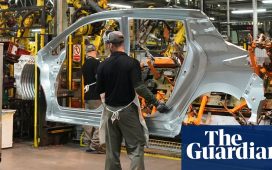While some automakers are chasing science fiction, others are grappling with the harsh realities of now: the car industry is a tough damn business to be in. Swedish automaker Polestar is in crisis. Its EV sales are tanking, the share price has hit rock-bottom and now it knows that it needs to mount a comeback.
Welcome back Critical Materials, your daily round-up of news and events shaping up the world of electric cars, software-defined vehicles and autonomous tech.
Also on today’s agenda: Stellantis CEO Carlos Tavares will step down in 2026 amid a broad management shake-up at the multinational conglomerate. Plus, the auto industry is giving Donald Trump the heebie jeebies. He hates EVs, he thinks hydrogen-powered cars are always blowing up and now he’s very, very concerned about autonomous vehicles. (I hate to admit it, but I do share some of his concerns regarding AVs.)
30%: Polestar Wants To Turn Things Around, Badly

InsideEVs
It really does. But first, let’s do a reality check.
The automaker released global third-quarter sales on Thursday and things don’t look good. Polestar delivered 11,900 cars in Q3, a 14% year-over-year drop as it delivered 13,900 cars during the same period last year.
In the first nine months of the year, it delivered 32,300 units across the globe. Volvo, by comparison, fared far better with its battery-electric and plug-in hybrid vehicle sales. It delivered 30,174 units of BEVs and PHEVs in September alone, across the world.
Here’s what new Polestar CEO Michael Lohscheller said in a press release:
Polestar has a great foundation to build upon, with access to the best EV technology, a global manufacturing capability and strong support from Geely. Together with the management team, we are conducting a review of our strategy and operations, to set out a clear path for Polestar’s development.
A key to our future success will be the development of our commercial capabilities: going from showing to actively selling cars. Adopting a more active sales model is already supporting our ambitions, as the first markets to implement it are showing solid order intake.
There have been some fundamental issues with Polestar’s EV strategy. Ever since it became a standalone performance EV brand separate from Volvo, it has struggled to differentiate itself.
I’ve tried explaining to my friends outside of the car industry what Polestar really is, but I wasn’t surprised when they didn’t get it. To them, Polestars seemed like slightly cooler-looking Volvos. And I don’t blame them.
In an SUV-dominated world, the automaker fielded the Polestar 2 sedan for a long time. It used to be a one-car brand. That changed recently with the Polestar 3 SUV and the rear-window-less Polestar 4 coupe. InsideEVs had a chance to review the Polestar 3 and we found that it’s a solid option, but perhaps not quite the game-changer Polestar needs.
But the automaker alone isn’t to blame for the tough situation it finds itself in. The Polestar 2 is made at parent company Geely’s factory in China’s Zhejiang province. That means the U.S. tariffs have hit Polestar hard.
Thankfully, the Polestar 3 is manufactured at Volvo’s South Carolina plant and the North American Polestar 4 coupe is produced at Renault’s plant in Busan, South Korea to sidestep tariffs on Chinese EVs.
Plus, Polestar is adopting a new distribution strategy that would fast-track vehicle delivery to dealerships so that customers don’t have to wait too long. With Volvo’s help, it’s creating new logistics hubs and attempting to be more consistent with inventory levels.
Moreover, after former CEO Thomas Ingelath departed in August, Polestar got a new boss in Michael Lohscheller. He’s an industry veteran with stints at DaimlerChrysler, Mitsubishi, Volkswagen and Opel—so he brings a ton of business expertise to the table.
So with new models out now, a revised business strategy and a change in leadership, Polestar isn’t just sitting idle. But whether all of this will help the brand survive and turn things around is something only time will tell.
60%: Stellantis Boss Will Step Down In 2026

Stellantis
Stellantis, which has more than a dozen brands under its umbrella including iconic nameplates like Jeep, Ram and Dodge has recently seen its profits drop. Its EV sales are a drop in the bucket compared to rivals, but now the automaker is making sweeping leadership changes across the globe.
It confirmed on Thursday that CEO Carlon Tavares will step down in 2026 at the end of his contract. His successor would be named by the end of 2025.
Stellantis also appointed Antonio Filosa as the North America Chief Operating Officer. He will also continue his role as Jeep’s CEO. That’s not it. Santo Ficili is the new CEO of Alfa Romeo and Maserati and Gregoire Olivier is the former COO of its China division.
The new bosses will hope that the automaker’s future isn’t entirely grim. Plus we’re seeing some action from individual brands. Jeep’s upcoming Wagoneer S aims to rival the Tesla Model Y, while a $25,000 electric Renegade is set to debut by 2027.
The Ram 1500 REV, with over 350 miles of range and 800-volt architecture, will almost certainly intensify competition in the electric truck space. And who’s not excited about the Dodge Charger Daytona EV with its fake, vibrating exhaust sounds?
90%: Trump Voices Concerns About Self-Driving Cars

Hours before Tesla revealed the Robotaxi at the Warner Bros. Hollywood studio in Los Angeles, Republican presidential nominee and Former President Donald Trump voiced concerns about self-driving cars at an event in Michigan.
“Do you like autonomous? Does anybody like an autonomous vehicle,” Trump asked the crowd at the Detroit Economic Club event as Quartz reported. “Some people do, I don’t know, [it’s] a little concerning to me,” he added.
Trump has been an outspoken critic of electric cars. He only softened his stance on EVs after Tesla CEO Elon Musk pledged $45 million per month to a pro-Trump Super PAC. His bromance with Musk peaked when the Tesla boss spoke at one of his rallies recently in Pennsylvania.
But I have to admit. Even though I despise his takes on electric cars, I share his concerns regarding self-driving cars, and even Tesla showed little proof last night that it was close to the promised land there. AI and autonomous driving experts told InsideEVs recently that Tesla’s technical approach with the Robotaxi, which will be guided by cameras and AI, is flawed.
There’s a long list of questions Tesla did not address at yesterday’s blingy reveal event. Like how would the Robotaxi perform in adverse weather without radar or LIDAR and what sort of business and operational infrastructure does it plan to establish?
100%: What’s Your Take On The Robotaxi Reveal?

InsideEVs
Tesla stock is down 8% the morning after the Robotaxi reveal.
The car itself looks rad and the Robovan is something out of a sci-fi flick. However, it was a shame that Tesla did not share any technical and operational details about the Robotaxi. That’s concerning because the We, Robot event was hugely hyped-up.
How does it plan to be a trillion-dollar company if it doesn’t have a roadmap regarding how these things would be safe in adverse weather or how the support infrastructure would look like? Leave your thoughts in the comments.
Contact the author: suvrat.kothari@insideevs.com









